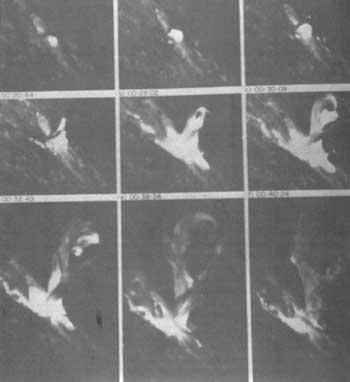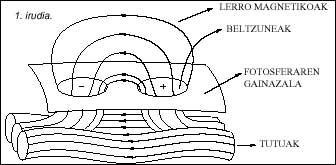Solar activity (II)
1989/05/01 Arregi Bengoa, Jesus Iturria: Elhuyar aldizkaria
After mentioning in the previous issue the structure of the Sun and the main peculiarities of its layers, we are ready to make known the activity that is generated in it, as the heliophysics can respond to the different aspects of these phenomena. This last comment we have to make about so many problems has a special reason in this case. Due to the intensity of the luminosity of the Sun its direct observation is not possible and, moreover, until a few years ago special instruments have been designed, the chromosphere and the crown could only be seen in total eclipses of the Sun.
On the other hand, as is known, when observations have been made through telescopes located on Earth, the information has been merely auditory and radioradiation, but lately this problem has been overcome with the help of the Skylab space and, above all, Solar Maximun Mission (SMM). The name can make us think that the only objective of the latter was to study the Sun. They were broken ten months after the launch of the ship and after four years in orbit repaired it. Although he sent less data than expected, his contribution has had a great importance in solving the problems that we will analyze shortly.
It has also been commented in the previous issue that the most prominent phenomena of activity in the Sun's atmosphere are factual, black, eruptions and bumps. The easiest to see are blacks, because they are the dark ones that, as the name suggests, can be seen in the photosphere. The fulas, on the contrary, are known because they create more luminous regions in the same layer. In addition, its effects also extend to the chromosphere.
The other two develop mainly in the chromosphere and crown. These distinctions can be made because each layer emits characteristic radiations of different wavelength of a band. For example, from the photosphere comes mainly visible light and from the deeper areas of this layer come infrared. From the photosphere and chromosphere binding region we receive millimeter waves and centimetric and metric waves provide chromosphere and corona information.
However, it should be noted that all these forms of activity that we have mentioned present a common peculiarity: their magnetic origin. This is also the reason for the relationship between some of the active phenomena. The Sun is not the only bipolar magnetic field that constantly changes from point to point as the Earth. Magnetic forces evolve locally based on the uniqueness of each region and the movement of matter and we can speak at most of the mean value of fields.
Let us try to describe and know phenomena. The fulas cause outflows of about 2,000 km of the surface of the photosphere, which in turn are more luminous. It is believed that these effects occur because by reinforcing the magnetic fields in this region, the convection current tends to order and help, increasing the internal hot matter more quickly.
Blacks normally form inside the fulas, but although they can be seen throughout the solar disc, blacks only appear between latitudes of 40º and -40º. Its appearance is not homogeneous. In the area there is a shadow surrounded by light that represents approximately 20% of the surface of the structure. The diameter of blacks ranges from 7,000 to 50,000 km, although, of course, they have also seen larger. For example, last March one of about 200,000 kilometers could be seen. As for the average duration, it only lasts a few days, but exceptions have been known that have lasted four months.
The photosphere temperature is estimated at around 6,500 K; the black light temperature is 5,500 K and the shadow temperature is 4,500 K. Therefore, blacks are quite luminous in themselves, and the contrast with the photosphere is what darkens our eyes. While in the case of fulas the influence of magnetic fields strengthened convection currents, as for blacks we must say that, instead of contributing to convection, the areas are so violent that they hinder convection. Therefore, hot matter rises less inside and therefore the temperature drops.
Bumps are structures similar to rings seen in the choir. Apparently they are formed by condensation of crown matter (like clouds in the Earth's atmosphere). Therefore, they are formed by matter at very high temperature. They are usually classified into two groups: kiesente and rapidly evolving. The first are quite persistent (3 months or) and large (200,000 km long, 50,000 km high and 8,000 km wide). They move, and although this point is not completely confirmed, it seems that they form in equatorial latitudes and head towards the poles.
The rapidly evolving bumps are much smaller. They last a few hours and are variable. Although the formation of bumps is not clear, the influence of magnetic fields in their evolution is clear, as in all other phenomena. This special importance of the magnetic fields we have mentioned at the beginning comes from the fact that matter is in plasma state in the Sun. It is a good conductor for the presence of ionized matter, and any variable magnetic field generates electric currents, also giving rise to magnetic fields.
In all the processes described, blacks have been the most known and observed throughout history. In the Chinese, Japanese and Korean ephemeris mention is made of the Morenos. In the West, on the contrary, the references are very scarce, perhaps because of the Greek and Christian conception of the immutability of the Universe. In 1611 the black Fabricius, Galileo and Scheiner began to be observed with a telescope, and since then we know their position, quantity and surface, but data collection was not systematized until 1750.
The analysis of this treasure of data has allowed us to conclude that the physical peculiarities of blacks evolve cyclically. This statement can also be made about other types of activities, and it has been proven that, taking into account the existing interrelation, periods are quite similar for all phenomena. Therefore, there is no doubt that solar activity evolves cyclically, and moreover, the blackest is considered an absolute indicator of the general cycle. Let us analyze the peculiarities of the latter.
The number of days per year in which the Sun presents the tanning and the number of units and groups thereof is used to obtain the representative Wolf numbers of the activity. Its most accused periodicity is 11.04 years. This season the activity goes through a minimum and a maximum. The first cycle begins by agreement at the minimum of 1755 and the period we have given before is the average value calculated with data from that date, since it is not totally constant. The season to a minimum has been 8 to 15 years.
It seems that according to the number and daily surface of tanning there is another period of about 80 years and another that follows cycles of maximum low level, but the latter are not fully confirmed, especially because the effects to study are very small and the number of measures is relatively scarce. As for the period of eleven years, the last, the 22nd, has begun with the 1986 minimum. Therefore, after the last maximum in 1979, we return to the expected maximum for 1990 or 91. Proof of this are the rashes and special tanning detected in March.
On this occasion, in order not to lengthen too much about the influence of the Sun's activity on Earth and the phenomenon that is most important from this point of view (the eruptions), we will finish the next number of articles.


Gai honi buruzko eduki gehiago
Elhuyarrek garatutako teknologia





